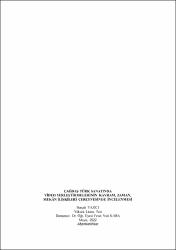Çağdaş Türk Sanatında video yerleştirmelerinin kavram, zaman, mekân ilişkileri çerçevesinde incelenmesi
Özet
Cumhuriyetin ilk yıllarından itibaren başlayan çağdaşlaşma süreci her alanda olduğu gibi Türk Sanatına da yeni ifade biçimlerinin kapılarını aralamıştır. Toplumsal olaylar ile birlikte siyasi, ekonomik, kültürel ve teknolojik gelişimler sanat alanını şekillendirmiştir. 1950’li yıllarda sanayileşme, modernleşme hamleleri, ekonomi politikaları ve dışa açılma süreçleri birçok kavramın ortaya çıkmasına neden olmuştur. 1980 askeri darbe sonrasında küreselleşmenin ortaya çıkması, İstanbul gibi büyük kentlere göçün başlamasını tetiklemesiyle birlikte, kültürel, etnik kimlik karmaşası ortaya çıkmıştır. Bu durum sanat alanını da etkilemiş ve sanatçı ortaya çıkan kavramları kuramsal çerçevede ele almıştır. Toplumsal hareketlerin yoğun olduğu 1980 döneminde üretim ve tüketim politikalarının artması özellikle kadın bedeni üzerinden oluşturulan popüler kimlik imgeleri sanatçılar tarafından yerleştirme, video gibi sanatsal pratiğe dönüşmüştür. Kavramsal Sanatın hakim olduğu süreçte yöntem ve malzeme çeşitliliğini arttırarak sanatçı geleneksel anlatımı yıkmıştır. Geleneksel sanat anlayışı teknoloji ve bilim alanındaki değişimlerden etkilenmiştir. Batı’da 1960’lı yıllarda hakim olan “video sanatı”, teknolojik gelişmeler ile birlikte Türkiye’de 1990’lı yıllarda hareketlilik kazanmıştır. Böylece sanatsal dil olarak kullanılmaya başlanan video, sanat alanına yeni bir söylem kazandırmıştır. Bu bilgiler doğrultusunda günümüz sanat anlayışı ve disiplinini anlayabilmek için video sanatının sanat alanındaki etkisini kavramak gerekmektedir. Bu çalışmanın amacı Çağdaş Türk Sanatındaki yeni ifade tekniklerinin oluşum sürecini video çalışmaları üzerinden betimsel bir inceleme yaparak önemini saptamaktır. The modernization process, which started from the first years of the Republic, opened the doors of new forms of expression to Turkish Art, as in every field. Social events, together with political, economic, cultural and technological developments, have shaped the field of art. In the 1950s, industrialization, modernization moves, economic policies and foreign opening processes led to the emergence of many concepts. With the emergence of globalization after the 1980 military coup and triggering migration to big cities such as Istanbul, cultural and ethnic identity confusion has emerged. This situation also affected the field of art and the artist handled the emerging concepts in a theoretical framework. The increase in production and consumption policies during the 1980s, when social movements were intense, turned into artistic practices such as popular identity images created by the female body, installations and videos by artists. The artist has destroyed the traditional expression by increasing the variety of methods and materials in the process of Conceptual Art. The traditional understanding of art has been influenced by the changes in technology and science. "Video art", which was dominant in the West in the 1960s, gained momentum in Turkey in the 1990s with technological developments. Thus, video, which started to be used as an artistic language, brought a new discourse to the field of art. In line with this information, it is necessary to comprehend the effect of video art in the field of art in order to understand today's understanding and discipline of art. The aim of this study is to determine the importance of the formation process of new expression techniques in Contemporary Turkish Art by making a descriptive analysis through video studies.
Bağlantı
https://hdl.handle.net/11630/10101Koleksiyonlar
- Yüksek Lisans Tezleri [1638]



















